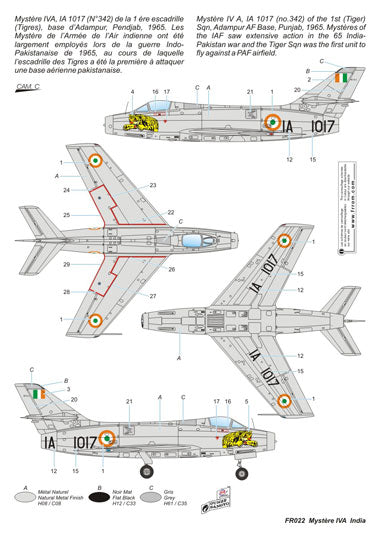Frrom-Azur
Frrom-Azur FR022 1:72 Dassault Mystere IVA India
Frrom-Azur FR022 1:72 Dassault Mystere IVA India
Couldn't load pickup availability
Frrom-Azur FR022 1:72 Dassault Mystere IVA
3 decals: IA 936, IA 1006, IA 1017
History:
The Ouragan (Hurricane) was the first of a long line of French jet fighters built by the Societe des Avions Marcel Dassault. Design work commenced just after the end of WW2 in 1946, whilst its entry into service was a short time later in 1952. The next design, the Mystere II, was an evolution of the straight winged Ouragan. It had a 30° swept wing as well as modified tail surfaces, and entered service in the Armee de l'Air in the spring of 1955.
The Mystere IV was based on further refinement of the Mystere II design concept. It bore an external resemblance to the earlier plane, but it had a revised wing structure that was also strengthened. The Mystere IV prototype first flew on 28th September 1952; the pilot on this occasion being Constantin Rozanoff. The prototype proved to be a great success; so much so, that the Armee de l'Air ordered the first batch in October 1952. Eleven pre-production airframes were soon followed by the production version. This was the Mystere IVA (MD-454), of which 411 were built. The first 50 aircraft had the Rolls Royce Tay 250 turbojet, whilst the remainder used the slightly more powerful Hispano-Suiza Verdon 350; which was a licence built version of the Tay.
A US military mission chose the Mystere IVA for a production run that the USA would pay for. In the Mystere IVA's case it funded the production of 225 aircraft for the Armee de l'Air.
The first unit of the Armee de l'Air to receive a production aircraft was the 12 eme Escadre, based in Cambrai (25th May 1955). The new fighter also served with 2 eme, 5 eme, 7 eme, 8 eme and 10 eme Escadres. The Patrouille de France air display team flew the Mystere from 1957 until 1963. After its withdrawal from first line units, it was employed in 8 eme Escadre at Cazeaux for advanced training, until November 1982, when it was replaced by the Aphajet in this role.
The Armee de l'Air and IDFAF flew the Mystere on operations during the Suez crisis of 1956.
France exported the Mystere IVA's to India and Israel; it sold 110 to the former and 61 to the latter. This followed on from the success of the Ouragan that was already in service with these nations. Israel flew them against their Arab adversaries in two wars (1956 & 1967).
The Mystere IVA began its service with the Indian Air Force in 1957. They first saw action during the 1965 war with Pakistan; and on September 7th, a Mystere destroyed an F-104 Starfighter during a raid on Sargoda. The Indian pilot, Sqn Ldr Devayya, was awarded the Maha Vir Chakra for this action. Nine days later a Mystere scored another victory by shooting down a Pakistani L-19. Mysteres also destroyed several Pakistani planes on the ground during the brief war; these included four F-86's, three F-104's and two C-130's.
The Indian Mysteres changed from the fighter to ground attack role shortly after the 1965 war, and they flew in this role during the 1971 war. However, by 1973 none were left in service.
Specifications: Wingspan 11.12m, Length 12.85 m, Wing Area 32 m2, Empty Weight 5,850 kgs, Max Speed at sea level 1,120 kmh (Mach 0.98), Ceiling 15,000 m, Range 1,310 km Armament: 2 x 30 mm DEFA 551 cannons, 907 kg payload on four external hard-points (12 x 105 mm rockets, 2 x 250/500 kg bombs or 4 x 70 kg or 2 x additional external tanks). Engine: 1 x Hispano-Suiza Verdon 350 delivering 34.4 kN of thrust.
Additional information and improvements:
starting from plane n° 150, the horizontal surfaces in tail are in one part ('monobloc'). You should then use the two unidentified parts, not parts 11 and 12. For planes in Armee de l'Air box, (excepted MAYBE the 312-UV) and those in India box, use these parts. For Israel, to be checked (probably monobloc)
the Pitot tube is missing (on starboard wing, see the box arts)
installation of Verdon engine required to open two small air intakes, symmetrical, on the fuselage. These air intakes have been omitted (see the India box art, in the fuselage cockade).
Tay engine might have been used in 111 planes. It seems Israel requested and had the Tay engine.
Tay: serial numbers from 1 to 74, from 77 to 114, planes 11, 23, 36 and 52 did get the Verdon on a maintenance operation. Verdon, starting at plane nr 115
The ejection seat provided in the kits is the Martin-Baker YAM-4, the first model installed was the SNCASO E95. Starting in 1967, the planes in Armee de l'Air service replaced the SNCASO seat by the Martin-Baker. We are researching informations for the Indians and Israelis planes (some sources state that the replacement was only done on French planes, other show at least an Israeli plane with a Martin-Baker seat).
The landing gear has to be shortened by some 2 mm and some weight should be added in the nose
The cockpit is black
The Indian flag is reversed (the green should be leading, in standard) BUT Dassault delivered the planes to India with the flag reversed. Naturally enough, the mistake was corrected later by the Indians. So you may choose to show an aircraft as it was on delivery or after correction. Nevertheless, there are only very slim chances that the tiger was painted with the reversed flag.











